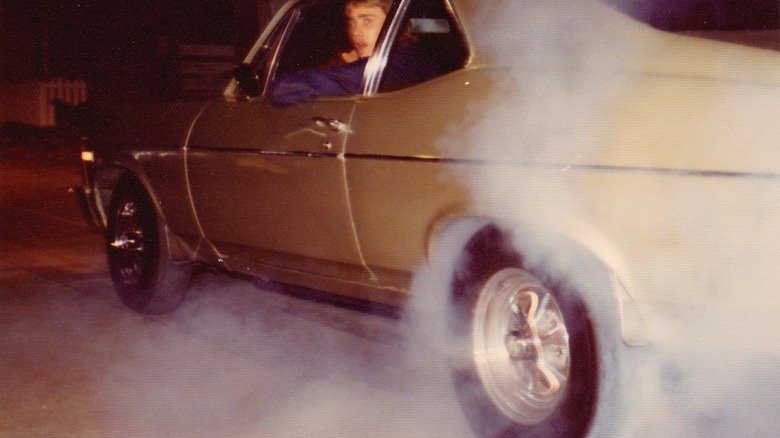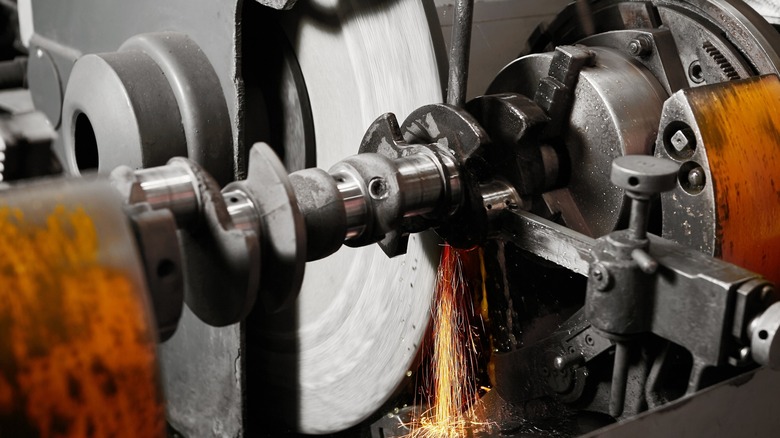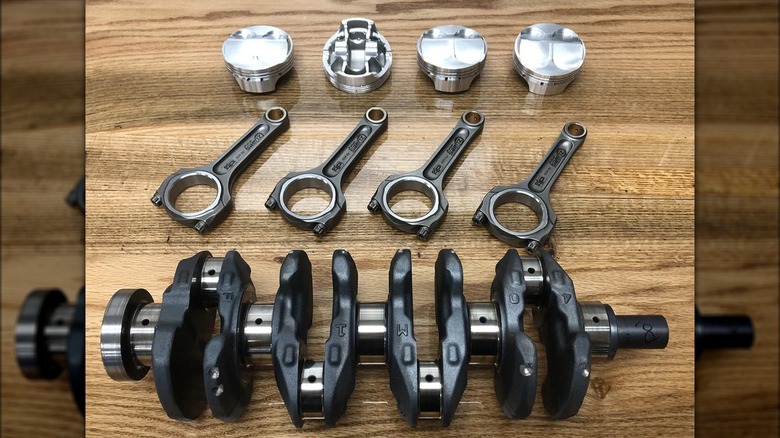What Is A Stroker Engine And How Is It Different From A Regular Engine?
Internal combustion engines are commonly referred to by their displacements whether its old-school cubic inches or more modern CC and liter nomenclature. If you love cars, you've no doubt heard of the Ford 427, Chevy 454, and Chrysler 426 HEMI. There is no shortage of iconic big-block engines to discuss.
Small-block V8s and four-cylinder sports car engines have their fans as well, with engine names like the 5.0L Coyote, 350 Small-Block Chevy, and K20. But where do those numbers come from? An engine's displacement is calculated using the diameter of its cylinders and the length of its crankshaft stroke to determine the volume of each cylinder. That volume is multiplied by the number of cylinders to get the total displacement.
There are two ways to increase the displacement of the engine in your car. You could bore the cylinders to a larger diameter, which requires larger pistons and is limited by cylinder wall thickness. Or you can build a stroker engine by installing a crankshaft with more stroke; however, there are limits to that as well.
[Featured image by NESR via Wikimedia Commons | Cropped and scaled | CC BY-SA 2.0]
How do stroker engines differ from regular engines?
The fact is that some of the most popular engine sizes are stroker versions of the engines that preceded them. The small-block Chevy (SBC) V8 lineup provides some great examples. It all started in 1955 with the introduction of the 265-cubic inch Turbo-Fire V8 featuring 3.75-inch diameter cylinders and a 3.00-inch stroke.
The late 1960's 302 SBC gained 37 cubic inches using the 265's 3.00-inch stroke and increasing the cylinder bore to 4.001 inches. The 327 SBC used the 4.001-inch bore with a 3.25-inch stroke, and the 350 SBC gained 48 cubic inches over the 302 by using the same 4.001-inch bore with a longer 3.48-inch stroke. The relationship between the Chevrolet 327 and its 350 successor reveals the latter's true stroker status.
Back before the internet and cell phones, hot-rod engine builders installed modified 400-cubic inch SBC crankshafts into 350 SBC engine blocks to create 383-cubic inch stroker engines. Today, you can order a complete stroker crate engine directly from Chevrolet, as well as DIY kits that include custom parts to simplify the process of creating a 383 stroker as well as other stroker engine sizes.
What's included in a stroker engine kit?
Summit Racing Equipment sells its 383-cubic inch Scat Engine Rotating Assembly for $1,196.99. This kit has the components necessary for converting your 350-cubic inch SBC into a 383 stroker engine, including a 3.75-inch stroke cast-iron crankshaft (forged-steel crankshafts are available), 0.030-inch oversize forged-aluminum flat top pistons with file-to-fit piston rings, 5.70-inch forged-steel I-beam connecting rods with caps and bolts, and enough main and connecting rod bearings to complete the rotating assembly.
Four-cylinder engine fans have multiple stroker engine kit options from 4 Piston Racing with prices starting at just over $2,000 for K20 and F20/F22C options without crankshafts and climb to over $3,500 for the 4 Piston K-Series Pro with an included Callies Billet Crankshaft. All 4 Piston Racing Stroker Kits include connecting rods and pistons at a minimum.
The K20 and S2000 F20/F22C Stroker Kits are designed to use a K24 crankshaft with a 99mm (3.897-inch) stroke. That's 15 percent longer than the 86mm (3.385-inch) stroke of the stock K20 crankshaft and nearly 8 percent longer than the 90.7mm (3.57-inch) stroke of a stock S2000 F20 crankshaft.
While these base kits don't include a crankshaft, there's an option to add one to the K20 kit, bumping the price up by $600. The S2000 kit requires a modified K24 crankshaft, and adding it raises the kit price by $900. In addition to the crankshaft options, you'll have choices for piston diameter and compression ratio to dial in the power output desired for your four-cylinder stroker project.


